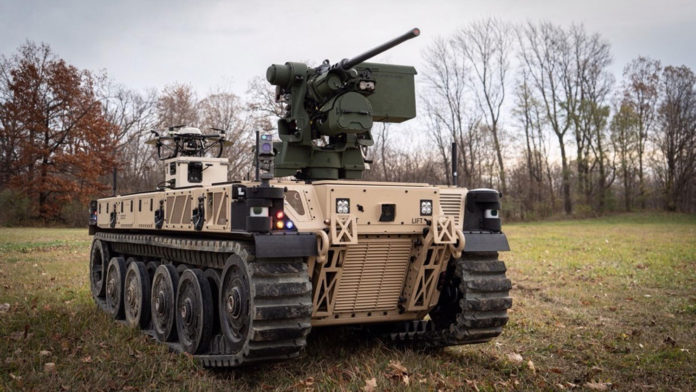The developer of robotic systems, QinetiQ, has delivered the first batch of experimental ground-based Robotic Combat Vehicle – Light (RCV-L) to the U.S. army. A batch of four machines will take part in field trials alongside Textron RCV-M (Medium) robots. These vehicles will be used to test the system of interaction of robotic complexes with people during combat operations.
In particular, during tests scheduled for 2022, RCV-L robots will form the first line of attack, which will already be followed by humans.
The RCV-L is a purpose-built hybrid-electric unmanned ground combat vehicle (UGCV) integrating technology from both organizations. It is developed on the basis of the Pratt Miller EMAV (Expeditionary Autonomous Modular Vehicle) chassis, a tracked platform with a hybrid power plant. It can travel over rough terrain at speeds up to 72 km/h and carry loads weighing up to 3.3 tons. In addition, the vehicle is compact enough to travel on the external sling of a CH-47 helicopter and a V-22 tiltrotor.
The first RCV-L received the Kongsberg CROWS-J remote-controlled combat module, which combines a 12.7-mm M2 Browning machine gun and the FGM-148 Javelin anti-tank missile system. The remotely controlled module is installed in traditional armored vehicles, where operators do not have to leave the armored cover to fire. In the RCV-L, it was additionally equipped with a tele-control system, which allows operators to issue commands at a great distance. The robotic platform can determine the target itself, but it will not work to open fire without the participation of the operator.
In addition, the RCV-L carries a HoverFly Tethered Unmanned Aerial System mini-drone, which can conduct reconnaissance of obstacles and buildings when the robot itself is in cover. The drone is physically connected to the RCV-L by a power cable and communication cord. This solution limits the flight range but provides almost unlimited autonomy. RCV-L can operate in fully automatic mode, except for the use of weapons.
Michael Rose, Branch Chief for Robotic Combat Platforms, GVSC Ground Vehicle Robotics said, “This unit is the first of four vehicles developed in support of the Manned-Unmanned Teaming (MUM-T) Soldier Operational Experiment, planned for 2022, and represents a significant milestone for the program. QinetiQ and Pratt Miller have successfully developed and delivered these systems within budget and on-schedule even in the face of the COVID-19 pandemic. The GVSC team now plans to add Autonomous Mobility as well as Government Furnished Software for the Tethered UAS Multi-Mission Payload and CROWS-J Lethality package.“
After testing the first batch of RCV-L, the military plans to purchase 16 more RCV-Land RCV-M for more complex experiments.
